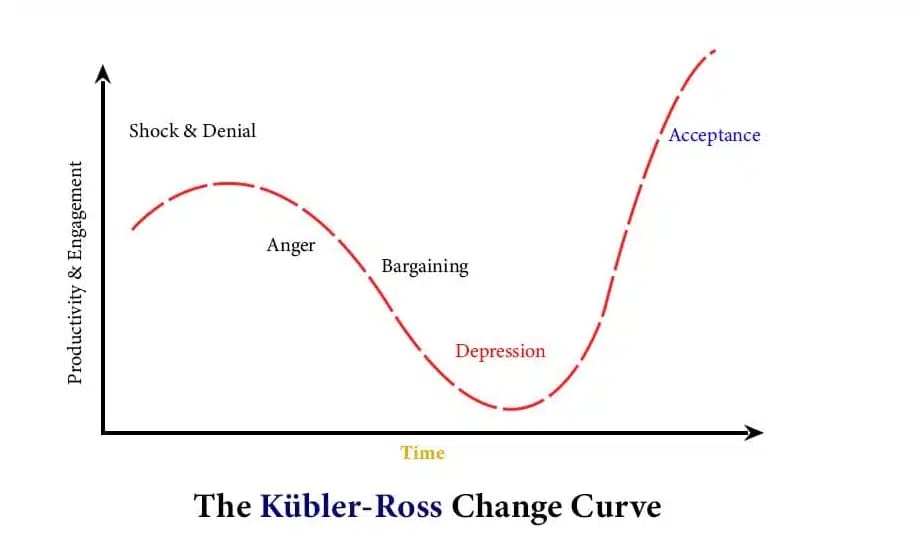Five stages of teaching a monkey to juggle
When introducing a new technology to an organisation, there are two crucial dimensions to attend to. The first is the technical side, which involves implementing the technology itself. This includes tasks like refactoring code, maintaining existing interfaces while changing the backends, conducting thorough testing, and validating the changes. There might be a "feature freeze" period, where the team cleverly launders technical debt into the new implementation. This process can be difficult and tedious. Ultimately it’s familiar territory that the team knows will be challenging, but manageable.
The second, and I want to make a case that, strictly more complex, is the cultural shift required within the organisation. This aspect deals with people and how they adapt to the new technology. While technical changes might feel routine, culture change represents the real challenge. These two dimensions—technical implementation and cultural adaptation—are interconnected, like two sides of the same coin. On one side (the "heads"), you have digital transformation; on the other side (the "tails"), you have change management. It’s where the greatest obstacles often lie, or, as the saying goes, here be dragons (’ tails).
The “teaching a monkey how to juggle” metaphor comes to mind. To engineers it feels familiar to jump into system design, abstractions and grand plans of “the big refactor”. But that is only, really, ever - the pedestal building. And ironically, by building the pedestal first - we shy away from the painful learning curve of transformation.
Let’s go through five stages of employee grief as “yet another”, “big T” transformation idea takes shape. Below are lessons from “Sooner Safer Happier”, a 2020 book about building productive, innovative teams.
Five stages
Shock and denial
An all-too-frequent pattern is for change to be dictated from the top. Instead of emerging organically, these changes are imposed on employees by those who are convinced they “know better.” This leads to the inevitable chorus of, “Here we go again!” about yet another fleeting initiative. Even worse, employees may perceive these transformations as potential threats to their comfort zones, or worse yet, their job security. And fear is the mind killer.
Anger
A shocked employee, may blame the latest fads, “out of touch” leaders or even exhibit ill will towards colleagues who consider this change to be potentially a good thing. It could lead them to become difficult to work with. Both morale and productivity is likely to take a hit as they withdraw towards their comfort zone.
Bargaining
When the spectre of change is not going away a common pattern is to appeal to company’s uniqueness. “We’re special! Sure it’s a good idea for others, but not for us!” Some aspects of change are beginning to take hold, with plenty of ring-fencing of old - comforting - ways of working. Some plans to sabotage or “work to rule” ideas may surface.
Depression
The most painful stage to many. From a happy employee who was in their stride before the “big T” we may begin to observe a husk of former self. Someone who’s performing their duties in a state of almost “learned helplessness”. I knew how to do things my way, and now with this change I feel like I need to ask for help each time. The uncomfortable state of needing to relearn mastery.
One can only take so much depression. The bigger the transformation the longer each individual stage. This is the biggest risk of “biting off more than one can chew”. It’s in this dark night of depleted morale that the battle is lost.
It’s here where empathetic and supportive leaders need to invest the most energy to remind the team that what’s awaiting on the other side is a place where bigger, better things are possible. It’s always darkest before the dawn. This is the time for all the optimism and courage the leaders can muster.
Acceptance
“…with empowerment, support and coaching; through starting to see the green shoots of better outcomes;” hope arrives. The big impediments to success: allowing learned helplessness to take hold, dogmatic - cargo cult - implementation of change through meaningless rituals, and crucially lack of psychological safety, of trust in the leaders and their vision.
Know yourself and your teams
Quiet conversations
Have a keen, empathetic eye, for your team and understand where each of the members is on the journey. Being able to quietly assess, and privately support them with an individually tailored approach will do wonders for the overall team morale and minimise the dips.
Don’t Teach Everyone at Once
Just as individual team members will react differently to change, some teams, on a larger scale, will be more enthusiastic. These are the "quick wins" that can be fully capitalised upon. Given the limited bandwidth to train teams to become fully self-sufficient, this selective approach is beneficial. Don’t move on to the next team until you’re confident a lasting change has been achieved. It pays to be diligent and ensure that everyone on the team is comfortable before progressing. This serves as the beginning of word-of-mouth marketing, acting as social proof that encourages the next group to take a courageous step toward transformation.
Do Keep Safe
Create a metaphorical staging environment where those who are learning can trip over their skis without the whole world watching. Invite those willing to experiment on-board, and ski alongside them. Make mistakes together. These shared experiences will build trust and pay off in unexpected ways well into the future.
#forces




